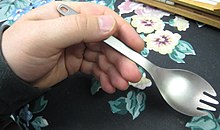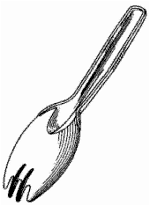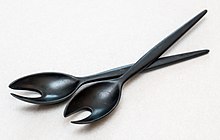| Revision as of 02:23, 12 September 2024 editGeneralissima (talk | contribs)Autopatrolled, Extended confirmed users, Page movers, New page reviewers, Pending changes reviewers11,096 editsNo edit summaryTag: Visual edit: Switched← Previous edit | Revision as of 18:59, 1 October 2024 edit undoFh287 (talk | contribs)4 editsNo edit summaryTag: RevertedNext edit → | ||
| Line 28: | Line 28: | ||
| ] | ] | ||
| Materials such as ], ], ], ], ] and ] have been used in spork manufacturing. Plastic sporks are common in prisons in the ] because they are difficult to form into ]-type ]s to attack other inmates. Prepackaged meals may come with a disposable plastic spork. Sporks are also frequently used by ], ] and other outdoorspeople as they are a lightweight and space-saving alternative to carrying both a fork and spoon. | Materials such as ], ], ], ], ] and ] have been used in spork manufacturing. Plastic sporks are common in prisons in the ] because they are difficult to form into ]-type ]s to attack other inmates. Prepackaged meals may come with a disposable plastic spork. Sporks are also frequently used by ], ] and other outdoorspeople as they are a lightweight and space-saving alternative to carrying both a fork and spoon. | ||
| Etymology | |||
| The term spork emerged in the early 20th century to describe combination utensils. In 1951, Hyde W. Ballard of Pennsylvania sought to register the term as a trademark for a stainless steel version of the utensil . Later, in 1970, the Van Brode Milling Company registered "Spork" for a plastic version of the utensil that also featured a knife-like edge. However, the registration expired in 1990 . | |||
| In the UK, Plastico Limited registered the term "Spork" for cutlery in 1975, and the trademark was defended in a 1999 lawsuit, where Justice Neuberger noted the cleverness of combining "spoon" and "fork" into a single term . | |||
| Modern Usage and Popularity | |||
| Today, sporks are available in a variety of materials including stainless steel, aluminum, titanium, polycarbonate, and biodegradable plastics. Stainless steel and titanium sporks are popular among campers, backpackers, and military personnel because of their durability and light weight. Plastic sporks are commonly distributed in settings like prisons, schools, and fast food chains because they are cost-effective and difficult to modify into harmful weapons . | |||
| One notable variation, the KFC spork, has become iconic, serving as both a useful utensil and a collector's item. KFC began offering plastic sporks in the 1970s, and they became popular due to their widespread use in meal boxes . | |||
| Specialized Sporks and Modern Innovations | |||
| In addition to traditional sporks, there are specialized versions designed for specific tasks. For instance, sporks for salads often have wider tines for gripping lettuce, and camping sporks sometimes feature a knife edge on one side. Some companies, such as Lifeventure, have developed multi-tool sporks that combine fork, spoon, and knife functionality into a single utensil . | |||
| Eco-friendly innovations in spork design are becoming increasingly popular, with companies manufacturing compostable or biodegradable sporks made from cornstarch, bamboo, or other sustainable materials . These options provide an environmentally responsible alternative to traditional plastic cutlery. | |||
| References: | |||
| Spork History and Development | |||
| Sporks in Fast Food and Camping | |||
| Early Spork Patents | |||
| Spork Etymology and Trademark Disputes | |||
| Environmental Concerns and Biodegradable Sporks | |||
| History of Spork Usage in the U.S. Military | |||
| Sporks in Pop Culture and KFC | |||
| Sporks and Prison Safety | |||
| Lifeventure Multi-Tool Sporks | |||
| KFC's Iconic Spork | |||
| These sources provide detailed information on the historical, legal, and modern uses of sporks, along with the significance of various materials and the evolving trends in their design. | |||
| ==See also== | ==See also== | ||
| {{div col|colwidth=30em}} | {{div col|colwidth=30em}} | ||
Revision as of 18:59, 1 October 2024
Item of cutlery in the form of a spoon with fork tines This article is about the utensil. For the film, see Spork (film).

A spork is a form of cutlery and combination utensil taking the form of a spoon-like scoop with two to four fork-like tines. Spork-like utensils, such as the terrapin fork or ice cream fork, have been manufactured since the late 19th century; patents for spork-like designs date back to at least 1874. Sporks are commonly used by fast food restaurants, schools, prisons, militaries, backpackers, and airlines.
The word spork is a portmanteau of spoon and fork. It appeared in the 1909 supplement to the Century Dictionary, where it was described as a trade name and "a 'portmanteau-word' applied to a long, slender spoon having, at the end of the bowl, projections resembling the tines of a fork". The word "spork" was later registered as a trademark in the US and the UK.
A utensil with a fork on one side and a spoon on one side is also known as a spork.
History




In the U.S., patents for sporks and proto-sporks have been issued. A combined spoon, fork, and knife closely resembling the modern spork was invented by Samuel W. Francis and issued US patent 147,119 on February 3, 1874. Other early patents predating the modern spork include US patent 904,553, for a "cutting spoon", granted on November 24, 1908, to Harry L. McCoy and US patent 1,044,869, for a spoon with a tined edge, granted to Frank Emmenegger in November 1912. Many of these inventions predated the use of the term "spork". Given this significant prior art, the basic concept of combining aspects of a spoon and fork is well established; more modern patents have limited themselves to the specific implementation and appearance of the spork. These design patents do not prevent anyone from designing and manufacturing a different version of a spork. Examples of modern US design patents for sporks include patent number D247,153 issued in February 1978 and patent D388,664 issued in January 1998.
Etymology
The word "spork" originated in the early 20th century to describe such devices. In 1951, Hyde W. Ballard of Westtown, Pennsylvania filed an application with the United States Patent Office (USPO; now the United States Patent and Trademark Office) to register "Spork" as a trademark for a combination spoon and fork made of stainless steel. The Van Brode Milling Company subsequently registered SPORK for a combination plastic spoon, fork and knife at the USPO on October 27, 1970, but the registration expired 20 years later. The word Spork accompanied by a stylised design is registered in the US in relation to hand tools, in the name of a UK-based individual.
In the UK, Plastico Limited registered "Spork" as a trademark in relation to cutlery with effect from September 18, 1975 (reg. no. 1052291, now expired). The trademark is also registered in the UK in relation to gardening tools in the name of the same UK based individual who owns US trademark registration no. 2514381. Another British company, Lifeventure, sells titanium and plastic versions using the name "Forkspoon".
In an unsuccessful lawsuit in 1999 where the company Regalzone sought to invalidate Plastico Limited's UK registration for Spork, Justice Neuberger wrote:
I accept that the word Spork involves a clever idea of making a single word by eliding the beginning of the word spoon and the end of the word fork. The fact that it is clever and the fact that the meaning of Spork could be said to be obvious once it is explained does not mean that it is obvious what it is. Indeed, I would have thought that if one asked a person in 1975 what a Spork was, he or she would not know. If one then explained what it was and how the word came about, one might then be told that it was obvious or that it was clever.
Materials and uses

Materials such as stainless steel, silver, aluminum, titanium, copper and polycarbonate plastic have been used in spork manufacturing. Plastic sporks are common in prisons in the United States because they are difficult to form into shiv-type weapons to attack other inmates. Prepackaged meals may come with a disposable plastic spork. Sporks are also frequently used by backpackers, Boy Scouts and other outdoorspeople as they are a lightweight and space-saving alternative to carrying both a fork and spoon.
Etymology
The term spork emerged in the early 20th century to describe combination utensils. In 1951, Hyde W. Ballard of Pennsylvania sought to register the term as a trademark for a stainless steel version of the utensil . Later, in 1970, the Van Brode Milling Company registered "Spork" for a plastic version of the utensil that also featured a knife-like edge. However, the registration expired in 1990 .
In the UK, Plastico Limited registered the term "Spork" for cutlery in 1975, and the trademark was defended in a 1999 lawsuit, where Justice Neuberger noted the cleverness of combining "spoon" and "fork" into a single term .
Modern Usage and Popularity Today, sporks are available in a variety of materials including stainless steel, aluminum, titanium, polycarbonate, and biodegradable plastics. Stainless steel and titanium sporks are popular among campers, backpackers, and military personnel because of their durability and light weight. Plastic sporks are commonly distributed in settings like prisons, schools, and fast food chains because they are cost-effective and difficult to modify into harmful weapons .
One notable variation, the KFC spork, has become iconic, serving as both a useful utensil and a collector's item. KFC began offering plastic sporks in the 1970s, and they became popular due to their widespread use in meal boxes .
Specialized Sporks and Modern Innovations In addition to traditional sporks, there are specialized versions designed for specific tasks. For instance, sporks for salads often have wider tines for gripping lettuce, and camping sporks sometimes feature a knife edge on one side. Some companies, such as Lifeventure, have developed multi-tool sporks that combine fork, spoon, and knife functionality into a single utensil .
Eco-friendly innovations in spork design are becoming increasingly popular, with companies manufacturing compostable or biodegradable sporks made from cornstarch, bamboo, or other sustainable materials . These options provide an environmentally responsible alternative to traditional plastic cutlery.
References: Spork History and Development Sporks in Fast Food and Camping Early Spork Patents Spork Etymology and Trademark Disputes Environmental Concerns and Biodegradable Sporks History of Spork Usage in the U.S. Military Sporks in Pop Culture and KFC Sporks and Prison Safety Lifeventure Multi-Tool Sporks KFC's Iconic Spork These sources provide detailed information on the historical, legal, and modern uses of sporks, along with the significance of various materials and the evolving trends in their design.
See also
- Grapefruit spoon – Kind of spoon intended for use with citrus fruit
- Combination eating utensils – Utensils with hybrid traits, such as sporks and knorks
- Lusikkahaarukka – spoon-fork combinationPages displaying wikidata descriptions as a fallback (spoon-fork in Finnish)
- Pastry fork – Eating utensil
- Runcible spoon – Nonsense word created by Edward LearPages displaying short descriptions of redirect targets
- Splayd – Combination spoon, knife and fork utensil
References
- Shepard, Helen-Marie (27 May 2002). "The splendid spork a marvel to behold". The Register Guard. Archived from the original on 12 May 2012. Retrieved 1 February 2009.
- Petroski, Henry (1992). The Evolution of Useful Things. Knopf. p. 135. ISBN 0-679-41226-3.
- ^ "Terrapin Forks (1890 - 1900)". Prices 4 Antiques.
- "The Century dictionary and cyclopedia; a work of universal reference in all departments of knowledge with a new atlas of the world". archive.org. Retrieved 2017-05-19.
- US patent 147,119
- US patent 904,553
- US patent 1,044,869
- US patent D247,153
- US patent D388,664
- US trademark application, serial no. 609,277, filed January 26, 1951. Official Gazette of the United States Patent Office, vol. 665, no. 3, p. 673, December 16, 1952. Accessed April 2, 2014.
- Jones, Stacy V. (December 20, 1952). "Small Fry Attempting to Get Peek At Yule Gifts May Be Caught in Act: Device Resembling Mouse Trap Registers Every Time Door Is Opened -- Another Patent Covers Rubber Beanie -- List of Inventions Patented In Week". New York Times. pp. 23, 27.
Hyde W. Ballard of Westtown, Pa., has applied for trademark registration of "SPORK" for a combination spoon and fork made of stainless steel.
- US trademark registration no. 901,492, filed October 24, 1969, registered October 27, 1970. Accessed April 2, 2014.
- US trademark registration no. 2,514,381, filed March 23, 2000, registered December 4, 2001. Accessed April 2, 2014.
- "Search for a trade mark - Intellectual Property Office". trademarks.ipo.gov.uk.
- D. Green & Co. (Stoke Newington) Ltd. and Plastico Ltd. v Regalzone Ltd. ETMR 241 (CA)
External links
- The Straight Dope on sporks Archived 2008-08-29 at the Wayback Machine
- The spork’s weird history, Bee Wilson, Salon